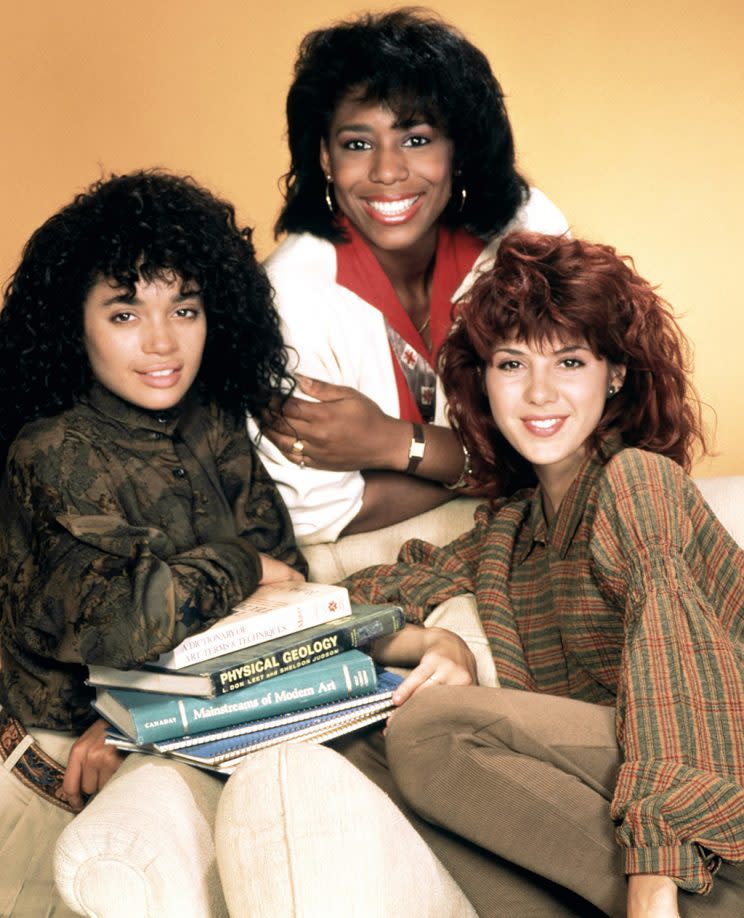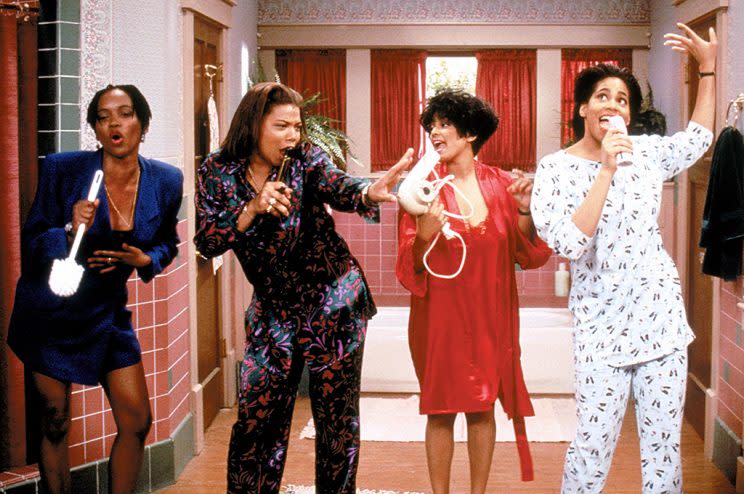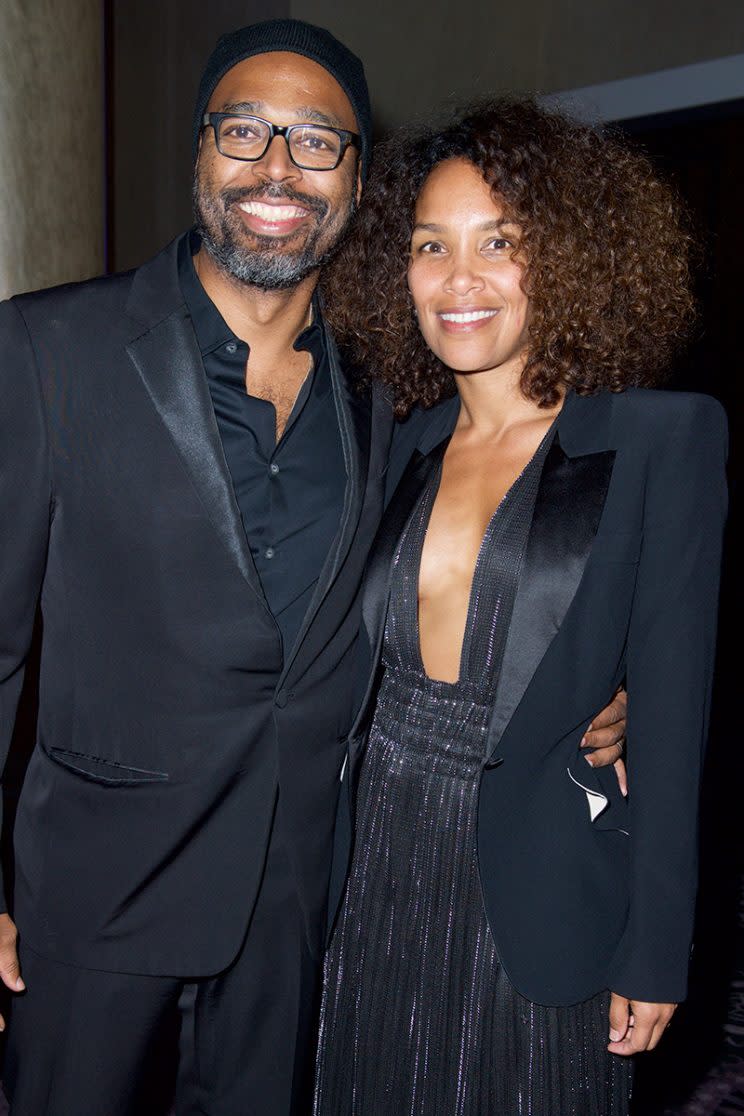‘Girlfriends’ Creator Mara Brock Akil Talks the Real Secret of Black Women on TV

“‘Congratulations to them,’ is what I want to say. It’s so awesome to be still relevant 30 years later and celebrated. They did something special.” That’s what Girlfriends creator Mara Brock Akil says when told 2016 marks the 30th anniversary of the premiere of Designing Women, the feminist CBS comedy that would defy stereotypes for women for seven seasons. She always liked that show, so much so that when she got to work with Designing Women co-star Meshach Taylor on Dave’s World, she went full-on fangirl. “I know he was like, ‘God, if this girl talks to me one more time about how much she loves me on that show…'”
As Yahoo TV celebrates great female friendships on TV in honor of that anniversary, we spoke with Akil, who also did something special and relevant in 2000, when she created a comedy centered on four black women — Tracee Ellis Ross’s Joan, Jill Marie Jones’s Toni, Golden Brooks’s Maya, and Persia White’s Lynn — that ran for eight seasons on UPN and the CW and launched a spinoff, The Game, which wrapped a nine-season run on BET last year.
Related: ‘Designing Women’ at 30: A Tribute to the 4 ‘Man-Loving Feminists’ Who Changed TV
Yahoo TV: What friendships on TV resonated with you when you were young and maybe even influenced your storytelling?
Mara Brock Akil: Well, it’s funny, because Golden Girls was just something that, even when I wasn’t initially paying attention, it was just there. And then you start to pay attention and it’s like, “Oh, it’s funny and it’s irreverent,” and it reminded me of my grandmother so clearly. It has been a strong influence in my life. I remember [Bea Arthur] in Maude. I loved her. Interestingly enough, though, A Different World was the show that made me want to participate in the storytelling. It was just so good, and I saw myself: I was pre-college, and Lisa Bonet’s character was going off to college. It was my everything. It was appointment television, and they had all sort of dynamics about girlfriend friendships included, and I loved it. At the time, I was studying to be a journalist, but I do believe that’s when the seed was planted.

At the time that Girlfriends was born, so to speak, Sex and the City was in the zeitgeist. What I enjoyed about Sex and the City was that it was like, “Oh my god, this is how women really are?” It’s like, “Duh!” So I wanted to certainly be at the table of the conversation. What was disheartening about Sex and the City, and even Golden Girls, is just that it wasn’t even that they got the depictions wrong [of black women], it’s that there wasn’t even an attempt to be inclusive. It was almost like we were invisible. Sometimes being black in America, being a black woman in America, that is a part of your experience — except when you are with your own, you are allowed a safe place to be, and your girlfriend is a really rich relationship for you, and nuanced. It was meaningful on a very deep level, and I wanted to express that.
I also approached Girlfriends almost like a documentary of our existence, what we were thinking about at the time. What we were thinking about not only our friendships, but what we were thinking about our dreams, whether that included marriage or not, what we thought about sexuality, what we thought about the workplace, what we thought about being sometimes the only black person in the workplace, or because you were the only two black people in the workplace, you decided to be friends, meaning Joan and William [played by Reginald C. Hayes]. That friendship was born out of that experience. Those were the things I wanted to talk about. I wanted to put us at the table.
Related: ‘Sex and the City’ Producers and Real-Life Best Friends Talk Toughest Writers’ Room Debate
Big was a big part of Carrie’s life on Sex and the City, and I treated Joan and Toni as if they were Carrie and Big. If you think about the trajectory of their relationship, the ups and downs, even though Joan’s main goal was to have it all and find that man to marry while having the house and the career and blah blah blah, it was also about trying to hold onto this friendship that was deeply important — and vice versa. It wasn’t just one way.

Talking with Designing Women star Jean Smart, she said so often on shows, particularly comedies, the dialogue is interchangeable. What she liked about that show was that the characters were four distinct voices — you couldn’t give one of Dixie Carter’s Julia lines to Smart’s Charlene. Talking with Playing House creators Lennon Parham and Jessica St. Clair, they were saying that so often on shows, a group of female friends has “the bitchy woman, the slutty woman, and the nerd,” as if women can’t be all three. How do great shows, like those and Girlfriends, find that balance of characters being specific but not one-note?
For me, I start at the place that my characters are human. I start at the place that they are onions that are layered and meant to be peeled, just as we as human beings are. Sometimes, we only get to know someone as one aspect of who they are. Then you start peeling back the layers and understanding more and more about who they are — their vulnerabilities, their fears, their joys, all those other words that equal humanity.
Going back to your point about the tropes, I also lean into the stereotype. Toni, for instance… At the time and at the zeitgeist of that time, we were starting to dissect and understand and look at the gold digger, so that might be a type to draw people in, but it’s my job as an artist and a storyteller to tell why she got there. That’s one thing I will always thank Northwestern for, my Medill School background, is that the journalist says, “Why are you that way?” Why? Why? Why? Why? That’s where all the stories are, and that’s the fun part of the unlayering, if that’s a word. The hope, though, is that you can stay on the air long enough to show that. The audience and the network and all those stars that have to align to give you time to peel it back…
Related: From ‘Buffy’ to ‘Once’: Jane Espenson on Creating TV’s Best Female Friends
Something I noticed rewatching the Girlfriends pilot and the Designing Women pilot is that they both have a plot in which one of the friends (Girlfriends’ Toni and Designing Women’s Suzanne) decides to date another friend’s ex. Why was that a great plot for your premiere? The situation obviously establishes the different personality types quickly with how each person responds and the amount of loyalty they feel toward each other in the end.
It’s funny, like I said, I want to be at the dinner table of the conversation. It has been reported and purported that that subject is not as taboo for white women, to date each other’s exes, as long as there is openness about it. In the black culture, at that time, in that moment, it was like, no, you just can’t, even if they only dated once and hated each other on the first date. I wanted to play with this idea, whether it’s real or not, that white women could date someone’s ex and it was OK and that in the black community that is just a deal breaker. It’s like tear the house down, how dare she, we’ll never get over that.
Of course, it’s not 100 percent true, but I thought because it was such a collective thought, so to speak — whether you practiced it out loud or not, you collectively said, “No, black women don’t do that” — I wanted to challenge that and see if the friendship was strong enough to [overcome it]. And to your point, when it’s a subject that elicits a strong reaction, even from your audience, then it allows not only the characters to state their point of view and you get to understand how they think, but also as an audience member, I get to decide which one I like and don’t like or love to not like.

You went straight to UPN and you sold Girlfriends, and then you couldn’t find a studio to finance it until Kelsey Grammer stepped up with his production company. Why was that difficult?
Yes, I did it all backwards. I was a breech baby, so maybe it’s just like my life. I do everything backwards. One major reason was UPN was in question whether it was going to survive as a network. What studio wants to deficit finance something that may only be an outlet for a year or two and they can’t get their money back? From a business perspective, that’s why UPN was in trouble. But going deeper than that, I think because UPN at the time was a burgeoning network that had found a hit with Moesha and [its spinoff] The Parkers, some strength on the network on, I guess we called it Black Night [Laughs], so they wanted to fortify that with more programming, but the rest of the network wasn’t [that].
Let’s be honest: we’re still coming around to even valuing that storytelling that would center around black culture and women, and I’m doing both on one show. Talk about loving to go uphill. [Laughs] We were a group of talented people who had something to say and were passionate — we had value. We valued ourselves. We valued the stories we were telling. We valued the work we were doing, and we knew there was an audience out there for it, we just needed an opportunity. One of the big secrets from a business standpoint, how we were able to be successful, is I don’t think they valued it, so they kind of left us alone, and then leaving us alone gave us the space to figure it out the right way. So we sort of used that negative for our gain. That’s the beautiful part.

When you were doing press to promote the premiere of Girlfriends, you said, “Living Single was groundbreaking at the time, and we’re going to take it to a new level.” What do you hope Girlfriends’ legacy is?
When I sold the show, I told the network president at the time that I was going to give up all the secrets of black women. I told him that I was going to give the secrets! I knew that the biggest secret was that we’re human, too. I’m hoping that the legacy of Girlfriends is just that you can enjoy and connect to Joan, Maya, Toni, Lynn, and William and see your humanity reflected in theirs. That’s what I’m hoping that it did. I think that the next level was that we just showed you the humanity of these characters that are black and are women and that anyone — of any race, of any gender — can see their humanity reflected back in them.
I’ve seen you talk over the years about doing a Girlfriends movie. Is that still something you’d consider?
I’m always down. If you found somebody who found some money, give them my number. Tell them to email me. Let’s go. Let’s rock.

You and your husband, Salim Akil, recently sold a multi-camera comedy pilot to ABC called Documenting Love, about a modern-day power couple in the entertainment industry. Is that your main focus at the moment?
We have two pilots, that and Black Lightning [based on the DC character]. Primarily I’m taking the lead on Documenting Love, and Salim’s taking the lead on Black Lightning, dividing and conquering. I’m so happy to be back in that space. You sort of expand out of it [with Being Mary Jane], and for a minute, I was like, “I’m done with that medium.” The more I thought about it, I was like, “Wait a minute, I think there’s still something I can do here. It’s right under my nose. It’s right there.” It’s a little exciting to take what I’ve learned and bring it back to multi-cam, the way that we would do it now.
I’ve read that Mad About You is the inspiration for Documenting Love?
Yeah, it is an inspiration. I Love Lucy and Mad About You, but Mad About You especially. I love the nuance of relationship in a show like that. I loved that show. It would be nice to do that from our land, you know?

